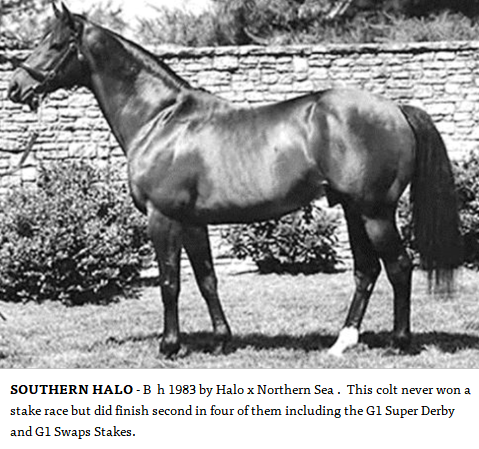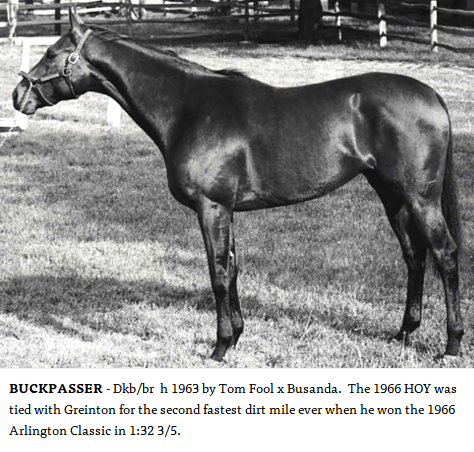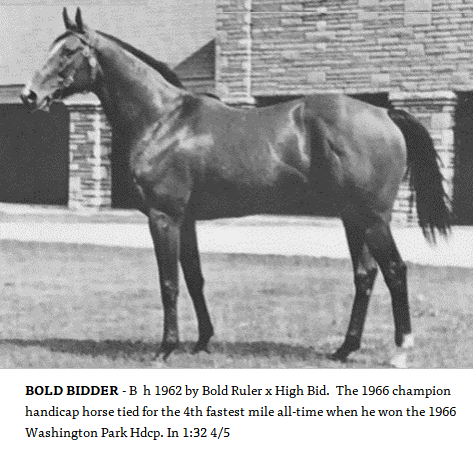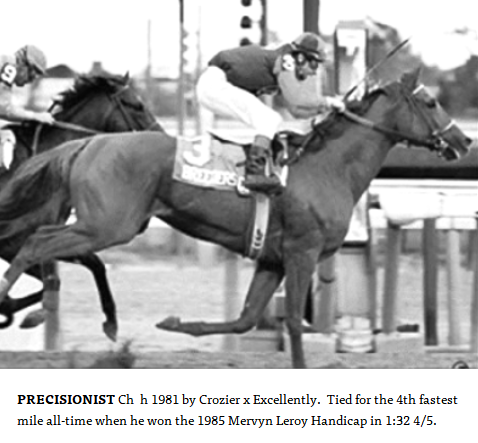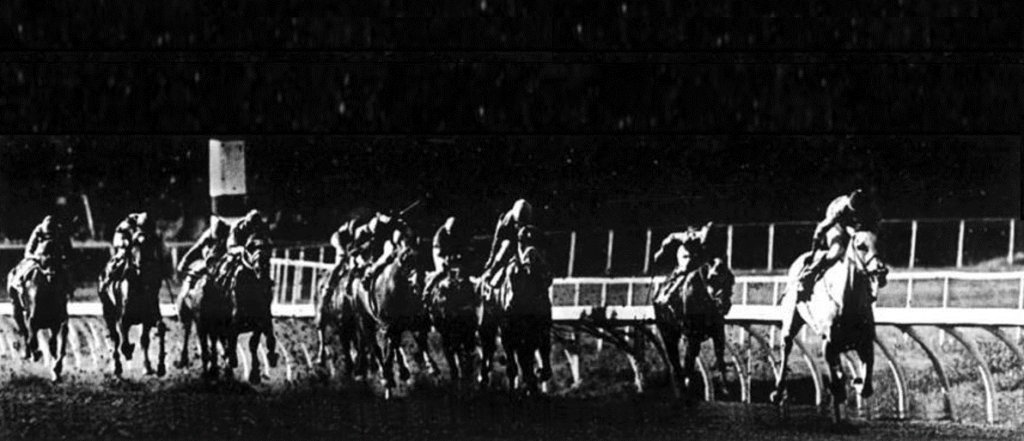
Melair……the California Comet
By: Walter Lazary /// January, 2024 /// 8,220 Words
In 1982, a two-year-old filly was taking the racing world by storm. Landaluce was always meant to be a good one, and even before she made her first-lifetime start, there was a buzz circulating around the backstretch about this fabulous young filly in Wayne Lukas’s barn. From the first crop of the great Triple Crown winner, Seattle Slew, and out of the lightly raced maiden, Poker Strip, this sensational filly broke her maiden in her first career start on July 3rd at Hollywood Park in a six-furlong Maiden Special Weight (MSW), dominating the field and drawing off to win by seven lengths in a spectacular 1:08 1/5. One week later, in her first stake race, Landaluce thrilled a crowd of more than 45,000 when she won the Hollywood Lassie by twenty-one lengths in an eye-popping 1:08, believed to be the fastest six-furlong race ever for a two-year-old filly around one turn.
After a two-month break, Landaluce returned to the track and easily won three more stakes, including the G1 Oak Leaf, and finished the year a perfect five for five with a combined winning margin of 46 ½ lengths. She was rewarded with an Eclipse Award as the nation’s top two-year-old filly. However, the award was given posthumously as, sadly, on November 28th, both her career and her life ended when she succumbed to a viral infection followed by a bacterial invasion that led to blood clots on her lungs and other organs. Ironically, Landaluce’s death came the day before the $518,859 Hollywood Starlet, the richest race ever for two-year-old fillies and one she was considered a cinch to win.
Throughout the fall months, people raved about the dark bay filly, many comparing her brief but spectacular career to that of the great Ruffian. She was that kind of girl, mentally tough with a strong will to win, a filly that many believed would not only be good enough to run in the 1983 Kentucky Derby but with more than enough class to win it.
After Landaluce’s death, a distraught Wayne Lukas, dressed in a dark suit and wearing sunglasses, addressed the media. “You can’t hope to replace a filly like this,” he said, choking back tears. The virus, which had not been specifically diagnosed, had affected approximately thirty other horses in the previous ten days, but none had died from it.
“We were amazed that she was able to keep whipping these things as they hit her,” Lukas continued. “And she did whip them all except for the last. The vets did everything they could but never really hit the problem. I am convinced that all we were doing was masking the symptoms. If there is anything good that can come out of this, it’s that the autopsy might tell us what happened and help the next fellow.”
Another Great California Filly
Four years later, people were still talking about Landaluce and what might have been when another potentially great California-based filly suddenly burst onto the scene. Her name was Melair, and in a period of ten weeks beginning on April 25th, this California bred by California-based parents would rise above her modest breeding and blaze her own path to Glory. And much like the tragic story of Landaluce, when Melair’s brief five-race career was suddenly cut short, racing fans would wonder yet again, “What if.”
Melair’s story began nearly twenty years before when two school teachers, Marianne Millard and Bea Rous, decided to own a few racehorses. Both taught in Torrance, California, where Beau was also the assistant principal and Marianne the guidance counselor. It was Bea’s father, who once owned a string of horses on the East Coast, who introduced her to the sport, and when she found out that Marianne shared her love of horses, they decided to do something about it and make their lifelong dreams become a reality. And so, as the story goes, at the end of the school year, they both resigned from their teaching posts, pooled their money, and purchased a small 20-acre parcel of land near Hemet, California.
Like all new ventures, it was not easy at first. They needed registered thoroughbred stock, and with very little money to invest, they decided that the best way to enter the sport was to claim a horse. However, in those days in California, before you could claim a horse, you had to own one. As luck would have it, there was an old beat-up plater for sale named Aberwhirl, a British bred who broke his maiden at Delmar in 1964 in a $7,500 maiden claimer and finished his career running in $3,000 claiming races two years later. The horse didn’t cost them much, and there was no way that it would ever earn them money on the race track, but it was a registered thoroughbred, and owning him opened the door and allowed them to put in a claim for their first race-worthy thoroughbred. Thus began what would be a modest stable and breeding establishment that would eventually reward them with one of the most spectacular fillies in recent memory.
As horse breeders, you might say that Marianne Millard and Bea Rous were moderately successful. One of their first mares was Venus, by Sun Again, who foaled the fillies Veneke and Market Again, both destined to become minor stake winners. Veneke was the most successful of the two, winning nineteen times and earning $165,000, while her younger half-sister finished with fifteen wins and earned $143,000. In fact, it was Veneke, a daughter of the Bold Ruler stallion, Neke, who gave the partnership its first-ever stakes victory in 1971 when she won the $15,000 Carmel Handicap at Bay Meadows, a stake that her younger sister Market Again would win two years later.
In 1973, Millard and Rous decided to claim a two-year-old filly named Melrose Nugget for $6,500. Those who knew about the filly warned them that they were making a mistake, that Melrose Nugget wasn’t much and, in her brief career, was already rapidly plummeting to the bottom rungs of the claiming scale. Luckily for the partnership, the ladies ignored these warnings and made the claim.
Later that year, the two-year-old gray won her first race. It came in a six-furlong $8,000 maiden claiming race at Bay Meadows on December 21st. Bet down to 6-5 favoritism, Melrose Nugget defeated eleven other fillies in an average time of 1:12 4/5. Following that, she stepped up in class and won a one-mile entry-level allowance race at Santa Anita on January 11th. Sent off at 4-1, she led all the way and was an easy winner by three and one-half lengths in a slow time of 1:44 on a muddy track. That race marked the pinnacle of Melrose Nugget’s achievements on the racetrack. Soon after, she was back in claimers and eventually retired with two wins in eleven lifetime starts and earnings of $11,000.
Barely breaking even, Millard and Rous still thought that their $6,500 claim was a good one, especially for a filly that was by Viking Spirit, a stallion that had won nine stakes in its career, including wins over Native Diver in both the Premiere Handicap and San Francisco Mile, and the 1964 Belmont Stakes winner, Quadrangle, in the Californian Stakes. Viking Spirit also sired Market Again.
With her racing days now over, Melrose Nugget began her new career as a broodmare, a journey that would see her excel beyond Millard’s and Rous’s wildest dreams. Her 1976 colt, Melscott, by Doc Scott A., finished third in the Debonair Stakes to multiple stakes winner To B or Not and grade one winner Crested Wave, who won the 1978 Belmont Futurity. In 1986, Melrose Nugget’s 1981 colt, Rosies K T, by KFAR Tov, won the G3 Los Angeles Handicap and pushed the champion sprinter, Groovy, before finishing second to that one in the Ancient Title Stakes later that fall.
But it was Melrose Nugget’s next foal that would leave her mark on the racing world, a roan-gray filly by the chestnut stallion Debonair Roger.
Debonair Roger was a 1976 foal by Raja Baba out of the Lucky Debonair filly Fresh Deb, who raced on the tough New York circuit and broke her maiden in a MSW at Aqueduct early in 1974. She only won one other race in her twenty-two career starts before she was retired.
Raja Baba, by Bold Ruler, was a half to Sauce Boat, which made only five-lifetime starts and won the G1 Arlington-Washington Futurity. Primarily a sprinter, Raja Baba won several minor stakes but was a prominent sire. Two of his best offspring were Is It True, which defeated Easy Goer in the 1988 Breeders’ Cup Juvenile, and the millionaire filly Sacahuista, who won several grade ones, including the 1987 Breeders’ Cup Distaff.
Debonair Roger only made ten starts in his racing career, and the colt’s lone stakes victory was the G3 Eldorado Handicap in 1979. He also finished second to To B or Not in the six-and-one-half furlong Baldwin Stakes, which was taken off the turf. The colt had a modest career at stud, but like Fresh Deb, he would also leave a lasting impression on the sport, that impression being Melair, the gray filly’s name derived from a combination of both her sire’s and dam’s names.
Initially, Millard and Rous were not overly excited about Melair. She looked pretty ordinary to them, and Millard described her as: “A spindly little filly. You could hardly tell what color she was, kind of an off-gray, and she had so many spots on her she looked like she was tattooed.” Rous said that she was not ugly, “She was just plain, as nondescript as a bridal-path rental. If she were a human, she would have had to settle for a blind date.”
When Melair was shipped to Mexico to trainer Juan Garcia, a specialist in breaking and developing young horses, he was a little apprehensive at first, but he quickly changed his early impression of her once he saw her on the training track. “Melair,” Garcia told the school teachers, “Is one of the fastest horses I’ve ever seen. It’s not just that she’s fast; I have never seen a horse go that fast so easily. You could put a bowl of soup on her back, and she’ll rush around the track without spilling a drop in 1:08 flat.”
John Sadler, who today has over 2,400 wins and numerous stakes victories to go along with twelve California training titles (he won the 2018 Breeders’ Cup Classic with Accelerate and the 2022 Classic with Flightline), was thirty years old when he welcomed Melair into his barn. Unraced at two because Millard and Rous did not like to start their horses too early, the filly would make her first career start in a MSW for three-year-old fillies at Hollywood Park on April 25th, 1986. Most punters were aware that she was fast as her morning works often stood out, but she was still quoted at 9-2 on the morning line along with three other fillies, behind the 7-5 favorite, Rare Starlet, ridden by Alex Solis, and 4-1 shot, Crazy Eyes, ridden by a young Gary Stevens.
It was a lovely day for late April, hot, with only a hint of a breeze, but by the end of the fourth race, many in the crowd of more than 16,000 were turning heads and looking at each other, everyone trying to digest what they had just witnessed. Melair, ridden by her regular rider, Pat Valenzuela, and off as the second betting choice at 5-2 behind the 6-5 favorite, Rare Starlet, charged out of the gate like a salty veteran and quickly put away the field as she romped to a three and one-half length victory in 1:10 flat.

Millard and Rous were happy, and Sadler liked what he saw. Melair had passed her first test with flying colors, and a little more than three weeks later, the young trainer entered his verging star in a $20,000 six-furlong allowance race on May 18th. This time, the field was much stronger, with her main competition coming from Flying Julia, a filly that would win the G1 Santa Margarita Invitational in 1988 and, the following year finish second in both the Vanity and Milady Handicaps to the great Bayakoa.
When the gates opened, 29,000 people watched as Melair broke sharply from the five post. She was immediately challenged by 70-1 shot Bambalor, who had her head in front through the opening quarter in 21 4/5 seconds. This would be the only time in Melair’s brief career that she would not be on the lead throughout her races. Showing the determination of one who likes to be in charge, Melair shifted gears and easily drove past Bambalor, who by then was valiantly trying to keep up. From there, Melair took off and put on an awesome display of speed and agility, taking the field to the half-mile pole in 44 4/5 seconds while on her way to a nine-length victory over Flying Julia, who came from last to get second by a head over Argentario. But it wasn’t just the win that impressed the fans and injected a sense of excitement at what they just saw. It was the time and Melair’s absolute domination. This average-looking filly, the result of modest breeding and with a physique that didn’t suggest anything special, showed that she was indeed special and that she owned this track, stopping the teletimer in a final time of 1:08 3/5, with internal fractions of 21 4/5, :44 4/5 and :56 2/5.
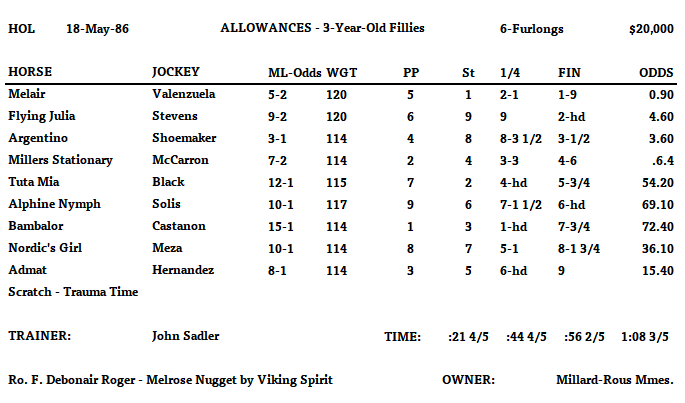
After the race, despite how dominating her performance was, especially seeing that it was only her second lifetime start, some people were impressed, but others said that there was a track bias that favored front runners. It could be that the track aided in her performance, especially when one considers how Flying Julia closed but couldn’t put a dent in her lead. Others debunked this theory by stating that in the seven-furlong Triple Bend Handicap two races later, the odds-on favorite, Sabona, closed from fourth, five lengths back to get the win in a swift 1:21, with the three-quarters in 1:08 2/5. So much for the track bias.
Ironically, on the day that Melair established herself as a serious racehorse and one to definitely watch out for, across the country in Baltimore, Maryland, it was Preakness Day, and the nation’s leading three-year-old, Snow Chief, had just won the second jewel in the Triple Crown by four lengths over the Derby winner, Ferdinand, with Broad Brush nearly seven lengths further back in third. No one, especially the owners of a young upstart three-year-old filly and what was now considered America’s leading three-year-old colt, could even remotely imagine at the time that they would clash in a race that would make racing history just a few short weeks later.
With two races on her resume, racing fans were now taking notice and waiting for Melair’s next trip to the track. They didn’t have long to wait. Having shown her class when competing against allowance company, it was now time to try stakes company, and Sadler entered her in the G3 Railbird Stakes on June 4th, a seven-furlong sprint restricted to three-year-old fillies in which she was listed as the early 7-5 morning line favorite.
The quality of the field suggested that this race would be anything but a cakewalk. Melair’s main threat was Winter Treasure, who was coming off a five-and-one-half length score in the six-furlong Drama Critic Stakes. The filly, who was trained by Richard Mandella and would be ridden by Laffit Pincay, was a daughter of former California favorite Vigors and was out of the 1973 California champion mare Minstrel Miss. She was no slouch and later that year would defeat Family Style, a multiple G1 winner, and the 1985 two-year-old filly champion, in the Cascapedia Handicap.
Another filly that was gaining a reputation was the undefeated Comparability, who was trained by Willard Proctor. By What a Pleasure, the sire of the 1975 Derby winner Foolish Pleasure and the 1976 Travers winner Honest Pleasure, Comparability was out of the In Reality mare, Conveniently, who would foal some good ones over the years. Like Winter Treasure, What a Pleasure shouldn’t be taken lightly as she had won her first three lifetime starts and was coming into the Railbird off an easy win from off the pace in the six-furlong Terlingua Stakes on April 28th.
It is not easy for an allowance-winning filly to take on proven stake winners, especially in only her third career start, but Melair wasn’t just another good filly. She was a cut above, and on this day, just as it would be in every one of her subsequent races, it made no difference who she faced or what their credentials were. The crowd of 16,227 watched in amazement as this young upstart gray exploded from her five post and rolled down the track with long, effortless strides through an opening quarter in 22 seconds and the half :44 4/5. Comparability, stranded on her outside a half-length back, tried to stay with her, but Valenzuela changed gears, and the Glen Hill Farm filly quickly dropped back as Melair opened up. In the end, she crossed the line seven and one-half lengths in front in 1:22 2/5, with Comparability hanging on for second by a half-length over 87-1 shot Silent Arrival, while Winter Treasure finished a non-threatening fourth.
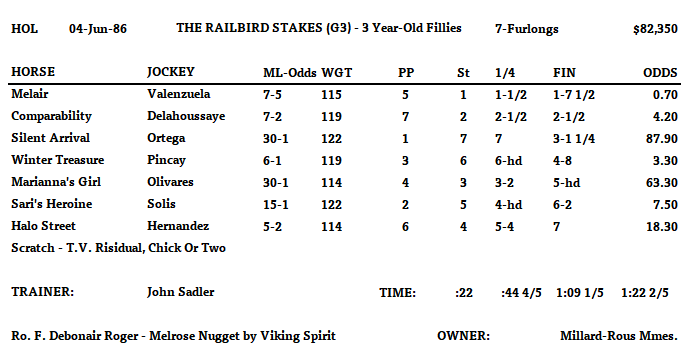
When a horse wins a stake race, invariably, the media takes notice and begins to ask questions. And when Sadler, whose career was gaining momentum, was asked about Melair, he praised her and said, “She’s done everything we’ve asked of her and more.” When queried as to why Melair never ran as a two-year-old, he said, “There was nothing wrong with her last year. It’s just that her owners Marianne Millard and Bea Rous don’t like to run their horses as two-year-olds. Last winter, this filly had a cough, but it was only a minor setback.”
Seventeen days later, Melair was at Hollywood Park, this time for the one-mile G3 $75,000 Princess Stakes. And though she had wowed racing fans with her dominating performances leading up to this race, she would not be listed as the morning line favorite. That honor went to one of the nation’s leading three-year-old fillies, Elizabeth Beck’s Hidden Light, who, despite her dismal seventh-place finish in the Kentucky Oaks to Tiffany Lass as the 5-2 second favorite, was still considered the best three-year-old filly on the west coast.
Regally bred, Hidden Light was by Majestic Light, a four-time G1 stakes winner of the Man O’ War, Haskell, Monmouth Invitational, and the Swaps. A versatile runner, he was equally adept on turf and dirt, though he was mainly considered a turf horse. Hidden Light’s dam, Tallahto, was also a star and numbered among her three G1 stakes victories: the twelve-furlong Oak Tree Invitational on turf over colts, the nine-furlong Vanity Handicap, and the ten-furlong Santa Barbara.
The Kentucky Oaks had been tough on Hidden Light, and her performance certainly wasn’t an indication of her class, as she was undefeated in four lifetime starts going into the race. She broke her maiden on November 4th, the previous fall, at the Oak Tree Santa Anita meet, winning a six-furlong MSW by seven lengths in 1:10 1/5. Away from the track for three months, she returned on February 22nd in a six-furlong allowance and got up to beat Fashion Dynasty by a nose in 1:09. Two weeks after that, she ran in her first stake race, the La Habra, a six-and one-half furlong dash on the turf. She ran the distance in 1:14 4/5, defeating the G3 stakes winner, Saris Heroine, by a length and a half with Top Corsage, a filly that would win twelve stakes in her career, including the G1 Spinster, finishing third.
In her final start before the Kentucky Oaks, and off as the 3-5 favorite, Hidden Light was a resounding winner of G1 Santa Anita Oaks, defeating the 1985 Juvenile Filly Champion Twilight Ridge by a length and a half with Family Style, second in the Breeders’ Cup Juvenile Filly the previous fall, finishing a non-threatening fourth.
In defense of Hidden Light’s lackluster seventh-place finish in the Oaks to the undefeated Tiffany Lass, her trainer Charlie Whittingham said that she was in season that day and her mind wasn’t entirely on horse racing. He also pointed out that he had worked her hard with the eventual Kentucky Derby winner, Ferdinand, in several morning sprints leading up to both the Oaks and the Derby, which in the end might have helped Ferdinand but, in hindsight, had been too demanding for the filly.
Despite her loss in the Oaks, Sadler respected the filly, who was the 7-5 morning line favorite. “You’ve got to write off Hidden Light’s race in Kentucky,” he said before the Princess. “After all, Snow Chief lost in Kentucky too, and look what he’s come back to.”
When asked if he was concerned because Laffit Pincay would ride his filly instead of her regular rider Pat Valenzuela, who was sitting out a five-day suspension, Sadler replied, “Not at all. Laffit is one of the best, and he fits a filly like Melair perfectly.”
The field for the Princess was a good one. There were other fillies to be concerned about, such as G3 winner An Empress, who was second in the Hollywood Oaks, and the Wayne Lukas trained Arewehavingfunyet, which won the G1 Oak Leaf the previous year and also finished second in the G1 Delmar Futurity to Tasso, with Snow Chief finishing third. However, as the money poured through the pari-mutual machines, it was obvious that the betters weren’t really looking beyond the two favorites, and Melair would go off as the overwhelming 3-5 favorite, with Hidden Light a close second choice at 2-1.
There were 26,107 in attendance when the gates sprung open. As usual, Melair flew out of them, and while running three-wide down the backstretch, she was immediately challenged by Comparability and longshot Marianne’s Girl for the first quarter of a mile, which she reached while in front by a half-length in 22 2/5. Hidden Light was also a noted front-runner, and many in the crowd fully expected her to go right to the top, but her jockey, Willie Shoemaker, didn’t want to get into an early battle for the lead that he knew he wouldn’t win. When his filly broke, sixth and last, Shoe didn’t push her. Instead, he took his time and gradually moved her up to be fourth on the outside and let her settle in.
Up front, Melair was strong and appeared to be toying with the two fillies on her inside. It was when she neared the end of the long backstretch run and was still running hard that Shoe decided that it was time to take a run at her. Going to the whip, he moved Hidden Light up on the outside and managed to get within a length of the lead as Melair flashed past the half in 44 3/5 seconds.
With the two fillies beginning to draw away from the field, the crowd was on its feet cheering, but if they thought they were going to see a fight to the wire, they were mistaken. Melair had always been in charge in every race she had ever run in and this time it would not be any different. She responded when Pincay showed her the whip, and by the time they reached the three-quarter pole, she had extended her lead to a length and a half. She was now in complete control and while barely under a hand ride, she dug in and lengthened her lead, finally passing the wire three and a half lengths in front of Hidden Light with An Empress rallying late to get up for third. The time was 1:34 1/5 with fractions of 22 2/5; 44 3/5; 1:08 4/5; and 1:21 1/5.

After the race both Marianne Millard and Bea Rous were smiling ear to ear, and why not? Melair was becoming a fairy-tail, the little unappealing filly that probably wouldn’t have brought them two thousand dollars if they had sold her as a yearling. Now she was a stakes winner and had defeated other stakes winners, including Hidden Light, a filly that was reputed to be the best filly on the West Coast and in the top five three-year-old fillies in America. But it was Melair’s time that also wowed people. For her first race at a mile, it was sensational, 1:34 1/5, which equaled the time wrung up by Fran’s Valentine the previous year, the only other year that the Princess Stakes was run at this distance. And to duplicate what Fran’s Valentine had done was also special. The daughter of Saros was all class, having crossed the line first in the 1984 Breeders’ Cup Juvenile Fillies only to be disqualified. She would eventually win a trio of G1 races at three, including the Kentucky Oaks.
When questioned after the race, Sadler admitted that he was worried when Hidden Light moved up to challenge Melair on the far turn. “I was concerned because my filly had gone so fast early:44 3/5 for the half and 1:08 4/5 for the six furlongs.” The obviously elated trainer then broke into a smile and said. “Laffit told me that he thought she was going fast, but it didn’t seem like it, as fast and easy as she was going.”
“She was very impressive,” said Pincay, who ironically was also the regular rider for Landaluce. “She has a stride. When Hidden Light came alongside, I thought we were going to fight it out. Then she drew away. This filly is very special.”
Charlie Whittingham, who had recently been released from the hospital after surgery for a sinus condition, was eager for a rematch. “Hidden Light had been away for a long time since her disappointing Kentucky Oaks, and this sets her up good for the Hollywood Oaks.”
Laz Barrera, who trained An Empress, also hinted that he would like to see if Melair could handle an extra eighth of a mile, which she would be faced with in the nine-furlong Hollywood Oaks. “The winner had too much speed today,” he said. “The track was favoring horses that got to the front. I thought my filly ran a good race, considering that she came from dead last.”
When queried, both Sadler and Pincay were optimistic that Melair could handle longer distances. Saddler said that he thought Melair might make a good middle-distance runner and said, “I think she can be rated. Even though she ran very fast early today, she gave us a good kick at the end.”
Pincay said that he felt Melair could at least get a mile and an eighth. “She has such a long stride that she doesn’t kill herself.”
Sadler also said that he would nominate Melair for the one-mile Silver Screen Handicap on July 5th, a race against colts. Hollywood Park, which was trying to lure Snow Chief, had increased the purse to a whopping $400,000, up from the original $100,000. The Silver Screen was scheduled one day before the Hollywood Oaks, which was to be Melair’s next race, but Sadler wanted to keep his options open in the event that Snow Chief didn’t enter.
Snow Chief had already made the trek west and was on the grounds. The black colt was stirring up a great deal of interest in the backstretch, especially when he worked a mile between races in 1:36 4/5. Rival trainer Gary Jones was impressed. “He clicks off those twelve-second furlongs like they’re nothing,” Jones said. If anyone was qualified to judge a horse’s class it was him as he would eventually train 2011 Horse of the Year, Havre de Grace.
Veteran Mel Stute, Snow Chief’s trainer, said, “I’m happy as long as he gets those last quarters in 24 seconds or faster.” In his monster work, Snow Chief went the first six furlongs in 1:13 and clicked off the final quarter in 23 4/5. “When he goes out like that, you wouldn’t think he would finish as well as he does, but he does,” Stute added.
The next few days were trying ones for Marianne Millard and Bea Rous. Melair’s latest win moved her up the ranks in the three-year-old filly division, with many considering her behind only Tiffany Lass, the undefeated winner of the Kentucky Oaks. With her perfect record after totally dominating some good fillies, offers began to come in from eager buyers, and they were substantial, ranging from of $800,000 to $1,500,000, but the two ladies turned them down.
“In the 1980’s it seems that everything has its price,” John Sadler said. “But not for these two ladies. All they want to do is have a nice horse.”
With those issues out of the way, it was time to plan the silvery grey filly’s next race. There were two possibilities: the $400,000 Silver Screen Handicap, for three-year-olds, scheduled for Saturday, July 5th, and the $150,000 Hollywood Oaks, for three-year-old fillies, the next day. After agonizing all week, it took until 7:00 p.m. on Friday night before the two ladies, in discussion with Sadler, finally decided to opt for the Silver Screen. “It was very difficult getting our three heads together on this,” Rous said. “But we finally decided that Melair might not like the 1-1/8 mile distance and the fact that she has to go around two turns in the Oaks.”
The 1986 Silver Screen Handicap
With Melair committed to the Silver Screen Handicap, there was an additional concern. She would leave from the outside post in the large thirteen horse field, not favorable as far as the two owners and Saddler were concerned. But the fact that Snow Chief would leave from the rail position, which was not a favorable post either for a mile race with such a large field, helped to ease their tension. “I was more worried about the outside post for our filly than anything else,” Saddler said. “But Snow Chief might not have a favorable post position either.”
“It’s a long straightaway which might give Melair a chance to get over,” Rous said in reference to the fact that the race would be around one turn and start in the chute as opposed to the nine-furlong Oaks, which would start in front of the grandstand and was a two-turn race.
One person who applauded the decision to run was Wayne Lukas, the trainer of Southern Halo and a man who was not afraid to run his fillies against colts. “They’ve got all the reason to run,” he said. “The shorter distance. Less weight. And the outside post position coming out of that chute at a mile that cinches it. Do you know what the worst post position going a mile on this track is? It’s the number one. The second worst? It’s the number two. The third worst? It’s the number three. The farther out you are in this kind of race, the better off you are.”
And so, the decision to run was confirmed, a lone filly against eleven colts as the field was reduced to twelve when Prince Bobby B was a late scratch. Saddler was confident she could handle most of these, but several would be tough.
Snow Chief was undoubtedly the favorite going in. Like Melair, he was a California bred who rose above his breeding and was considered the best three-year-old colt that year. He was by Reflected Glory and out of the Snow Sporting mare, Miss Snowflake. Snow Sporting was an Argentinian import that, in 1970, won both the Strub Stakes and Gulfstream Park Handicap. Miss Snowflake won only one race in five career starts but produced fourteen foals in the breeding shed. One of them, a 1988 colt by Alydar named Mujaazif, sold for $1,000,000 at the 1989 Keeneland sales and won two minor stakes in England. By far her best foal, though, and probably the one that pushed the auction price up on Mujaazif, was her first one, which was Snow Chief.
Reflected Glory was considered one of the best three-year-old colts early in 1967 when he won the Bahamas Stakes over Bold Hour and Cool Reception. He then defeated thirteen other Derby-eligible colts in the Everglades Stakes. After he won the nine-furlong Flamingo Stakes in 1:48 2/5 over In Reality, he pushed past Successor and became the co-favorite to win the Kentucky Derby with Damascus.
At that time, Reflected Glory was sitting on top of the world. Many felt he was better than Damascus, and the Derby would prove it. Then it all came apart. Off at 3-5 in the Florida Derby, he finished seventh to In Reality, and a short time later, it was announced that he would miss the Triple Crown races because of sore shins, after which his career tailed off. As a sire, some of his best offspring were the G1 filly, A Kiss For Luck, California champion filly Hot N Nasty, and the G1 winner, Summer Siren, all of which were foaled before Snow Chief.
As a two-year-old in 1985, Snow Chief won four stakes, including two G1s, the Norfolk and the Hollywood Futurity, in which Ferdinand finished third. At three, he won both the Florida and Santa Anita Derbys before finishing a disappointing eleventh as the 2-1 favorite in the Kentucky Derby to Ferdinand. Rebounding nicely, he won the Preakness by four lengths over the Derby winner and the $1,000,000 Jersey Derby at Garden State on May 26th by two lengths over the Champagne Stakes winner, Mogambo. He was without question the leading three-year-old colt and was entering the Silver Screen, having won seven of his previous eight races.
Another colt that was a concern was Vernon Castle. By Seattle Slew out of the Prince John filly, Rullian’s Princess, Vernon Castle punched his ticket to the Kentucky Derby by winning the G2 Californian Stakes in a fast 1:48 over Imperious Spirit and Prince Bobby B. After a lackluster fifteenth place finish in the Derby the colt tried the G2 Cinema Handicap on turf and ran second, as the favorite, to Manila, which later that year would win the Breeders’ Cup Turf and be rewarded with an Eclipse Award as the year’s top turf horse.
Both Marianne Millard and Bea Rous realized that their gallant filly was in tough, and they were on edge with the usual owner’s nervousness when one of their horses was about to compete in a big race. For the fifth straight time, they repeated their superstitious ritual before Melair ran. This meant that they were dressed in the same outfits they wore when she made her first lifetime start on April 25th. Millard was dressed in burgundy pants and a sports shirt, while Rous was wearing a brown suede jacket and yellow pants. And, like always, they also carried a couple of shamrocks. Rous also never accompanied Millard to the paddock before Melair ran, but she did appear in the winner’s circle.
“We have different routines for all our horses,” Millard said. “We do other things when Rosie’s K.T. runs.” Then she smiled, “But I want to make it clear that we do wash our clothes between the times that we wear them.”
It was sunny and hot, which made for a lightning-fast track when the field of eleven colts and one filly paraded in front of the grandstand on their way to the chute at the far end of the backstretch. Melair was calm as usual, and if you did not know her you would probably think that she didn’t have much of a chance against all those colts, some of which were strong muscular types. Pat Valenzuela let her canter around the turn, the filly’s neck bowed like a stallion, as she was obviously ready for the task at hand. And for those who thought that everything was against her, it was not all bad. Besides what Wayne Lukas considered the best post in the race, she would also be getting a huge break in the weights as she would carry just 115 pounds. Snow Chief was the highweight at 127 pounds, which was ten pounds over the official scale weight of 117 pounds, while Melair, who would normally receive a sex allowance of five pounds, was actually carrying three pounds over scale.
An eager crowd of 36,417 looked on as the field was loaded into the starting gate. Most of them expected to see a good race, and many believed that Melair would give a good account of herself and had no qualms in making her the 9-5 second favorite behind Snow Chief’s 3-5 odds. Only one other colt had single-digit odds, that being Vernon Castle, which was 7-1.
As an excited grandstand waited anxiously for the start, it isn’t easy to imagine that anyone expected to see what was about to unfold, a performance for the ages by a filly with extraordinary talents, one that now rivaled the great Landaluce with her blazing speed and sheer dominance. When the gates sprung open, Melair, as she always did, exploded from her outside post and, in the blink of an eye had the lead by a length. In desperation, Willie Shoemaker, who was riding Southern Halo, took his colt out fast and tried to keep her away from the rail as the rest of the field was already running hard in a vain effort to stay close. Snow Chief, which wired a strong field in the Jersey Derby and pushed the outstanding sprinter Groovy hard for the first six furlongs before taking the lead in the Preakness, broke eighth along the inside. Alex Solis then took hold and hustled him up to be third as Melair sped through an opening quarter in 22 1/5 seconds.
As they continued down the backstretch, it was already evident that this was going to be a three-horse race. Melair was determined and continued to roll along, running a swift :22 2/5 second quarter, which took her to the half in 44 3/5. She was now a length and a half in front of Snow Chief, who was a head in front of Southern Halo, while Vernon Castle, who was fifth early on, slipped past Tripoli Shores and Chris McCarron into fourth spot.
At this point, everything about this race seemed normal……the speedy filly rocketing into the lead and setting torrid early fractions while the rest of the field sorted itself out and prepared to make a charge in the final quarter of a mile and put her away. But that’s not what happened. In fact, when they moved into the far turn jaws dropped and a stunned crowd looked on in amazement. With Snow Chief in position to strike, Melair suddenly opened up, and when she passed by the three-quarter marker, she was four lengths in front of Southern Halo, who had regained second by a length over Snow Chief……..and she did this by twirling out a demanding :23 2/5 third quarter as the teletimer flashed 1:08, a time that matched Landaluce’s in the six-furlong Hollywood Lassie.
But she still had that final quarter of a mile to run.
Turning into the stretch, the crowd was on its feet. Melair’s momentum carried her toward the center of the track, not good, but she still held that four length lead despite those taxing fractions. What really amazed everyone was that despite going wide, she was not finished just yet. She actually opened up even more and passed the eighth pole five lengths in front. From there, she roared towards the finish line like a true champion and went on to destroy the field by six-and-one-half lengths.
The crowd was in awe as the field was stretched out behind Melair in a finish that was so thrilling, not because the race was close, but because of her complete domination and the fact that she made it look so easy. Southern Halo was a clear-cut second by four and a half lengths, while Snow Chief managed to save third, eleven lengths behind the winner and a head in front of a charging Marvin’s Policy. Vernon Castle, after making a threatening move, faded back to eleventh, twenty-four lengths off the lead.
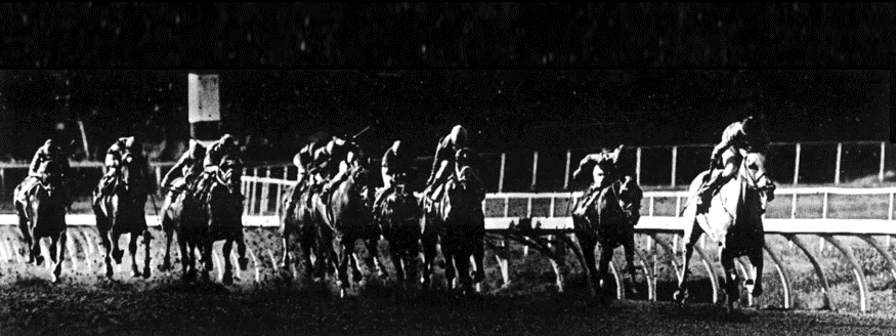
Melair leading the field to the wire in the 1986 Silver Screen Handicap..
The crowd was still in awe when Pat Valenzuela brought the gallant filly back to the front of the grandstand to be unsaddled. The teletimer said it all: 22 1/5; 44 3/5; 1:08; 1:19 4/5; and 1:32 4/5. She had just run the fastest mile ever for a three-year-old filly. Her time was also the fourth fastest all-time for either sex behind Dr. Fager’s 1968 world record 1:32 1/5 in the Washington Park Handicap at Arlington Park; Buckpasser’s 1:32 3/5 in the 1966 Arlington Classic Handicap also at Arlington; and Greinton’s 1:32 3/5 set at Hollywood Park in the 1985 Californian Stakes, that time being the current track record.
(Note: I believe that Melair’s mark was still the fastest race at one mile on dirt for a three-year-old filly until Gamine won the eight-furlong Mother Goose Stakes at Belmont Park in 1:32.55 (1:32 2/5) this year (2020). The older mare, Bayakoa, tied Melair’s time when winning the one-mile Hawthorne Handicap at Hollywood Park on May 20th, 1989).
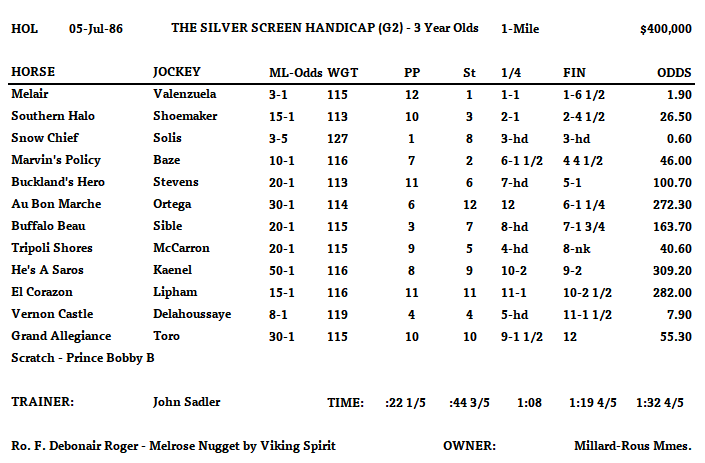
Melair also approached another mark which seemed to be exclusive to Hollywood Park. In 1972, Triple Bend set a new seven-furlong track record of 1:19 4/5 when winning the Los Angeles Handicap. That record stood until May 15th, 1980, when the filly, Splendid Girl, lowered it to 1:19 3/5 with her victory in the Silver Spoon Handicap. Just thirteen days later, Rich Cream, a Crème dela Crème five-year-old, lowered it again when he just got up to win the Triple Bend Handicap in 1:19 2/5, the lightning-fast horse’s second track record in two races as just the week before it tied Barrera’s 1977 six-furlong mark of 1:07 2/5. Two years later, in 1982, the three-year-old colt, Time to Explode, tied Rich Cream’s mark when winning an allowance race. For Melair to approach this mark when running in a mile race speaks loads of her quality as she tied Triple Bend’s mark, which stood as the third fastest seven furlongs in history.
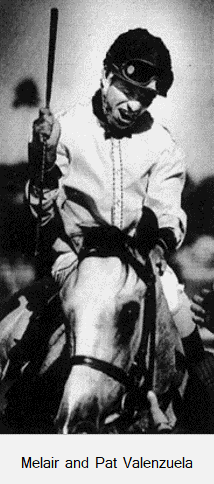
With Melair now in the history books and a perfect five for five, Sadler later admitted that he was nervous leading up to the race and hoped his filly wouldn’t lay an egg. “All my life, I’ve done things by the book,” he said. “I’ve learned things like not running fillies against colts too early, and this time, I followed my heart and not my head. I really thought she might get beaten.”
When she didn’t lay an egg, he compared her to one. “She’s like one of those eggs Malcolm Forbes would buy,” the trainer said. “You know, the kind where there’s only fourteen like them in the world. She’s an extraordinary horse, and this race proves that she’s the best three-year-old in the country.”
When asked about the way she exploded out of the gate, Sadler said. “Pat really didn’t hustle Melair out of the gate to try and get the lead. She did it on her own.”
Mel Stute did not use the inside post or weight as an excuse. “The filly was just too fast, too furious for us,” Stute said. “She ran a fantastic race. Everything was perfect for my horse until the three-eighth pole, but the filly just kept on running. We would have been second if we had not been on the inside, but we wouldn’t have beaten the filly. She was awesome.”
“She’s from another planet,” Valenzuela said. “She was so relaxed today. I kept looking for Snow Chief or some other horse, and when I didn’t see him, I put my stick away (after hitting Melair a few times). I really liked her for this race. I figured she’d already proved she could go a mile. And from the outside post, I knew I could do what I wanted with her.”
With the Silver Screen Handicap now history, it was announced that both Melair and Snow Chief were heading east, but not to run against each other. Melair was heading to Saratoga and the seven-furlong Test Stakes with a purse of $150,000 on July 31st. After that, she would be pointed to the mile and one-quarter Alabama on August 9th. Snow Chief would point to the $300,000 Haskell at Monmouth Park five days earlier on July 26th. This was the middle race in a three-race troika, and if a horse should win all three, it would receive a bonus of $1,000,000. Snow Chief had already won the first race in the series, the Jersey Derby at Garden State, and if he should win Monmouth’s Haskell, then he would be pointed to the final race, the Pegasus at the Meadowlands in September.
A few days later, however, plans changed for both horses. After a bout with colic, Saddler announced that they had decided to keep Melair in California and run her at the Del Mar summer meet but hoped to run her in the Maskette Stakes at Belmont Park on September 6th. At about the same time, Mel Stute announced that Snow Chief was to miss the remainder of the year because of a bone chip in his knee and was scheduled for orthoscopic surgery. He also added that he believed his colt might have suffered the injury during the running of the Silver Screen Handicap.
On July 28th, plans changed for Melair once again. John Sadler said that she needed a break and that there was nothing wrong with her. “She ran her eyeballs out in five tough races, and she just needs to rest,” he said. “She’ll be out until the fall or ideally until a series of races for four-year-old fillies, which is scheduled for Santa Anita next year.” He also said that Melair was not eligible for the Breeders’ Cup at Santa Anita on November 1st and that it was unlikely that her owners would supplement her for $120,000.
The Breeders’ Cup came, and the fanfare and excitement created by Melair and her fabulous Silver Screen Handicap was pushed to the back burner. The only two races she might have been considered for if she had been supplemented were the six-furlong Sprint or the ten-furlong Distaff. In either race, she would have been in tough. Smile won the Sprint in 1:08 2/5, defeating the tough four-year-old filly Pine Tree Lane by a length and a quarter, with the 2-5 favorite, Groovy, finishing fourth. The great Lady’s Secret, who would go on to be voted Horse of the Year, won the Distaff.
Exactly one week later, it was announced that Melair, who was still a candidate for the three-year-old filly title, was to return to training and would have her first breeze in a few days. However, she never did respond when on the race track and it was evident that something was wrong. On December 18th, the stable made another announcement. Melair was to be sent to the farm for an additional three to four months to get some much-needed rest. It was reported that she had been bothered by a cough and a virus that contributed to a bleeding condition.
On January 29th, the racing world learned that Melair had been retired and would never race again. She had suffered a second and much more severe bout of colic and had recently been operated on at a clinic in Bonsall, California. Veterinarian Joe Ross, who performed the operation, reported that 80% of her colon had been removed. “She is doing just fine,” Ross said. “But it would be a tad premature to be totally comfortable about her recovering. She is in that in-between stage, and it’s going to be at least another week before we can be sure about her.”
Melair survived, of course, and though Marianne Millard and Bea Rouse sold her dam, Melrose Nugget, just a few days after she won the Silver Screen Handicap, they kept their prized filly bred her several times, but always in two-year intervals because of her condition.
Marianne Millard explained that the operation had affected her capacity to carry foals, and they did not want to be too hard on her. They also kept her at their farm instead of sending her away to be bred because of a special diet and the fact that she needed special attention.
Melair would have six foals, all of which the two ladies kept and raced themselves. None of them ever won a stake though one of them, Airlaunch by Relaunch, was stakes placed at Turf Paradise.
Sadly, Melair passed away after yet another bout of colic in 1999. With her passing, she left a memory of a gutsy filly that, in a ten-week period in 1986, would perform like no other filly performed. For her efforts that year, she was runner-up in the Eclipse Award voting for the top three-year-old filly to Tiffany Lass. She was voted California’s top filly and top sprinter and was the Breeders’ Cup Horse of the Month for July.
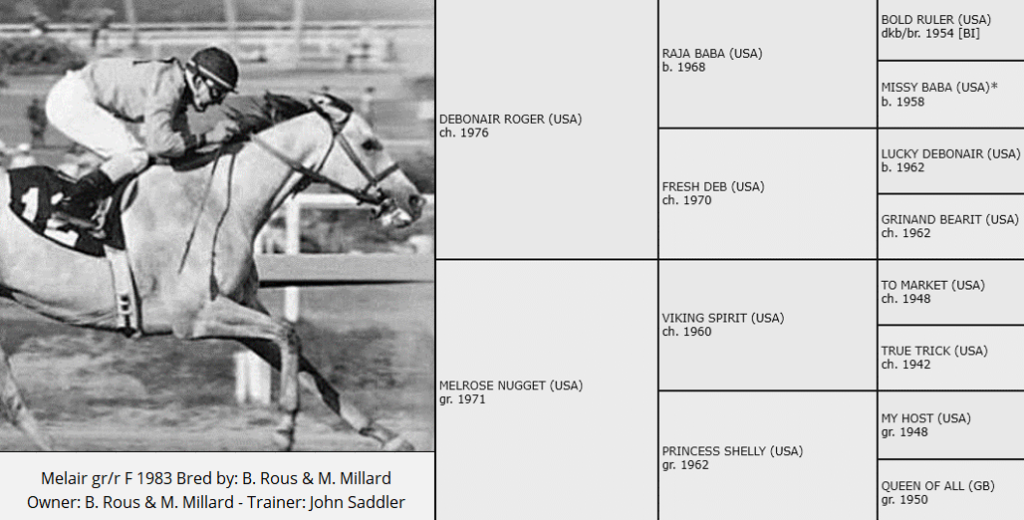
Tap on image below for slide presentation in LIGHTBOX.

